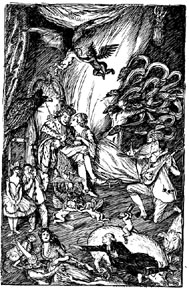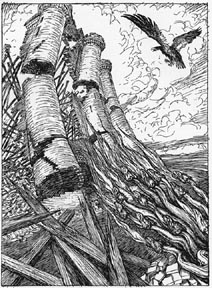Thomas Carlyle, who combines the pre- and post-Romantic intonations of the paradigm, exemplifies yet another option available to the nineteenth-century writer. Moving between two perspectives, he is able to convey both the meaning and the experience of an event, something he conceives essential to his self-appointed task as secular prophet.



Three illustratsions by Edmund J. Sullivan of Carlyle's French Revolution: Left: Louis XVI.
Middle: D'Orleans. Right: Lomenie-Brienne. [Click on the thumbnails for larger images.]
In the opening pages of The French Revolution we thus come upon poor Louis XV, the do-nothing king, "swimming passively . . . towards issues which he partly saw." Without vision, without conviction, he finds himself trying to make "incoherence into coherence," and he cannot. "Blindest fortune has cast him on the top of it: he swims there; can as little sway it as the drift-log sways the wind-tossed moon-stirred Atlantic" (pt 1, bk 1, ch. 4). Then there is D'Orleans, who, defending the prerogatives of the Convention against his brother Louis XVI, "has cut his Court-moorings, shall we say? And now will sail and drift, fast enough, towards chaos?" (pt 1, bk III, ch. 6). Unlike D'Orleans, Lomenie-Brienne, the finance minister who replaced Necker, clearly perceives his danger. Desperately seeking a plan, any plan, to keep [191/192] the national finances from going under, he asks the intellectuals of France to furnish him with one.
What could a poor minister do? . . . A sinking pilot will fling out all things, his very biscuit bags, lead, log, compass and quadrant, before flinging out himself It is on this principle, of sinking, and the incipient delirium of despair, that we explain likewise the almost miraculous "invitation to thinkers."
Invitation to Chaos to be so kind as build, out of its tumultuous drift-wood, an Ark of Escape for him! [pt: 1, III, 11. 81]
The invitation to thinkers leads to the return of the Estates General as France continues to float towards freedom, towards chaos, towards the deluge that will drown many good men and many, like Lomenie-Brienne himself, who are not of much value.
These examples reveal how complex is Carlyle's use of this metaphor in The French Revolution. Considered as an individual, Louis XVI is seen to be a decent, essentially good man who is shipwrecked through little or no fault of his own. Like his father, he looks heavenward and earthward and can find no guidance; he drifts and is destroyed by forces beyond his control. Considered, however, as king and as representative of a functionless aristocracy, a class that in Carlyle's view is a living lie, then Louis is seen to shipwreck as punishment. Appropriate to a work that combines history, epic, mock-epic, and sermon, the perspectives from which we view men and events continually change, thus controlling the way we react to these paradigms. Thus, when we see Louis and Marie Antoinette close at hand, we sympathize with them, whereas when we look at them from a distance, from outside their vantage-point, as it were, we judge them. As Carlyle moves us away from his characters, he also places us at the moral and philosophical center of his cosmos, so that when we perceive the plight of these people, we evaluate them not by their standards and needs but by what Carlyle takes to be eternal ones; and in larger terms we understand their destruction to be just, even deserved.
In the traditional Christian uses of the situation of crisis, the author and the reader alike view the disaster from the vantage-point of divine law; in Romantic and post-Romantic ones, they view (or experience) the destroying waters from within the sinking vessel, for the existence of divine law is itself in doubt. Carlyle's complex and ironic use of this paradigm in The French Revolution arises from the fact that although he concentrates on the situation of shipwreck from within, he is ultimately able to believe in a transcendental order of the kind that enables or requires us to judge the mariner from without. Nonetheless, despite the essential morality of Carlyle's source of eternal order, it cannot serve as a judging God because it is both impersonal and largely unknown. The result of this complex interplay of perspectives is that however much some of the characters may deserve the disaster they encounter, at some point in the narrative we are made to feel this shipwreck is something for which they are not responsible. Sympathy prevails.


Two of Edmund J. Sullivan's allegorical illustrations of Carlyle's French Revolution that capture the
Carlyean style : Left: Corruption. Right: The Walls of Jericho (The Fall of the Bastille). [Click
on the thumbnails for larger images.]
Last modified 16 July 2007
